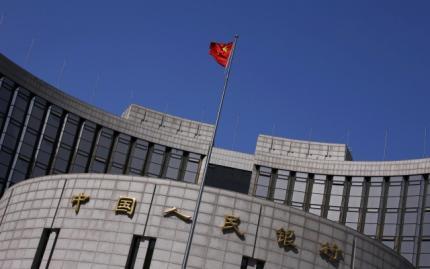China confident it has done enough to keep growth above 7 pc
• 06 Jun 2014

A Chinese national flag flutters outside the headquarters of the People's Bank of China in Beijing (REUTERS/Petar Kujundzic)
In April, the People's Bank of China (PBOC) cut the reserves requirement for rural banks by 0.5 to 2.0 percentage points
Bareksa.com - China has stepped up efforts to stop quarterly economic growth falling towards 7 percent and thinks it has been successful for now after preliminary signs that a rapid slowdown has been arrested, sources involved in policy discussions say.
That should give the government and central bank at least until the release of second-quarter growth data next month to decide whether the economy needs more intensive support.
Two policy steps in the past week significantly broadened the support to the economy without breaching vows to avoid major stimulus, through a quickening of government spending and a second targeted cut in reserve requirements for some banks.
The moves look intended to keep growth near 7.2 percent, which Premier Li Keqiang has said is needed to support jobs growth, without the central bank cutting the reserve requirement ratio (RRR) across the board or lowering interest rates.
"There is no need for such a move as long as we could maintain quarterly GDP growth rates of 7.2-7.3 percent, which could be a tipping point for policy change," Wang Jun, senior economist at the China Centre for International Economic Exchanges, a well-connected think-tank in Beijing.
"But growth data for Q2 does not look that bad."
The government usually solicits views and proposals from top think-tanks before making key policy decisions.
Annual growth slowed to an 18-month low of 7.4 percent in the first quarter, and some weak data for April raised concerns that momentum was being lost faster than expected.
A Reuters poll found analysts expect annual GDP growth to slow to 7.3 percent in the second quarter. Further, they expect full-year growth of 7.3 percent in 2014, the weakest in 24 years and below the government target of 7.5 percent.
The government has acted since April to steady growth through some focused measures, casting it as policy fine-tuning, and official manufacturing and service sector surveys showed improvement in May.
"The employment situation remains relatively stable, which gives the government more confidence about the economy and it believes it's too early to loosen policy across the board," Wang said.
On Thursday, the International Monetary Fund said it expected China to grow by around 7.5 percent this year and then slow to around 7 percent next year.
"We consider that vulnerabilities have risen to the point that containing them should be a priority, and therefore additional stimulus should only be deployed if growth slows significantly below this year's target," the IMF said after a mission completed a two-week trip to China.
MAINTAINING CONTROL
China's leaders have ruled out any large stimulus as the country is still nursing the hangover from the 4 trillion yuan ($640 billion) stimulus implemented during the global crisis in 2008-09, which resulted in piles of local government debt.
Instead, local governments have been instructed to quicken budget spending and complete allocations this month, a move analysts expect to support growth in the current quarter, but overall spending has not changed.
Major banks currently have to keep a fifth of their cash as reserves. Cutting that ratio across the board would free up funds for lending, which could give activity a boost, but authorities would not have control over where the cash went.
"We should not loosen monetary policy across the board and give money to whoever wants it," said Guo Tianyong, an influential economist at Central University of Finance and Economics in Beijing.
"Credit is not evenly distributed among different sectors and money will flow into sectors that are attractive for investors, such as the property sector."
In April, the People's Bank of China (PBOC) cut the reserves requirement for rural banks by 0.5 to 2.0 percentage points. Last week, the cabinet announced that it will cut the rate for banks whose lending was geared towards the real economy, although the central bank has yet to specify the size of the decrease.
"The targeted RRR cut does not mean a change in the direction of the prudent monetary policy," the official Economic Information Daily quoted Ji Zhihong, head of the PBOC's financial market department, as saying.
The paper quoted Zong Liang, deputy head of Bank of China's international finance research institute, as estimating the combined RRR cuts could release about 300 billion yuan.
Indeed, the central bank says there is already ample liquidity in markets, evidenced by money market rates falling in May, although rising commercial lending rates suggest it is not getting out smoothly to the broader economy.
"There could be more targeted measures," said a former central bank researcher who spoke on condition of anonymity.
FUNDING STRAINS
Apart from the headline growth rate, policy insiders say another potential trigger for a policy easing is capital flows.
Combined foreign currency purchases by the PBOC and banks fell to 117 billion yuan in April from 189 billion yuan in March, which JPMorgan China chief economist Haibin Zhu said indicated an estimated net "hot money" outflow of $8.2 billion.
Short-term speculative money has left China in response to slower growth and the central bank's suspected intervention this year to weaken the yuan, and analysts say sustained capital flight could weaken base money, which would raise official concerns about how companies could access funds.
Ultimately, they say the central bank will have to walk a fine line between reducing elevated debt levels in the economy while ensuring steady growth.
"The government's stabilisation measures and a recovery in exports may not be enough to offset the slowdown in the property sector," said Nie Wen, an economist at Hwabao Trust in Shanghai.
"If you push for deleveraging too fast, it could lead to systemic risks." (Source : Reuters)